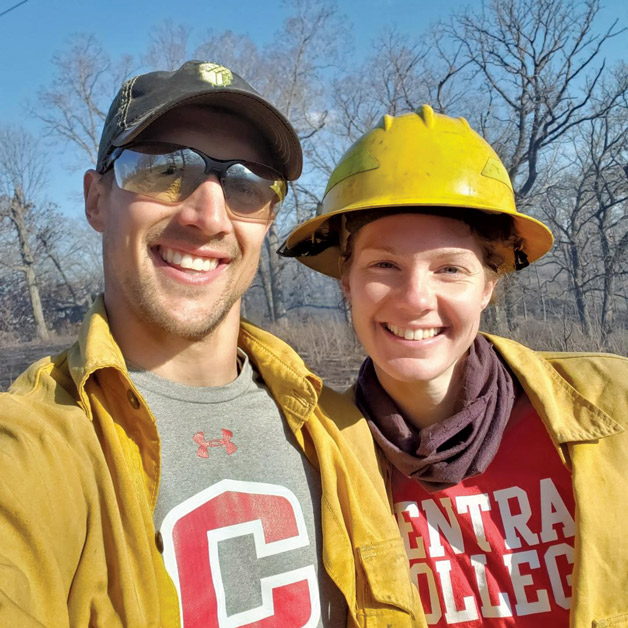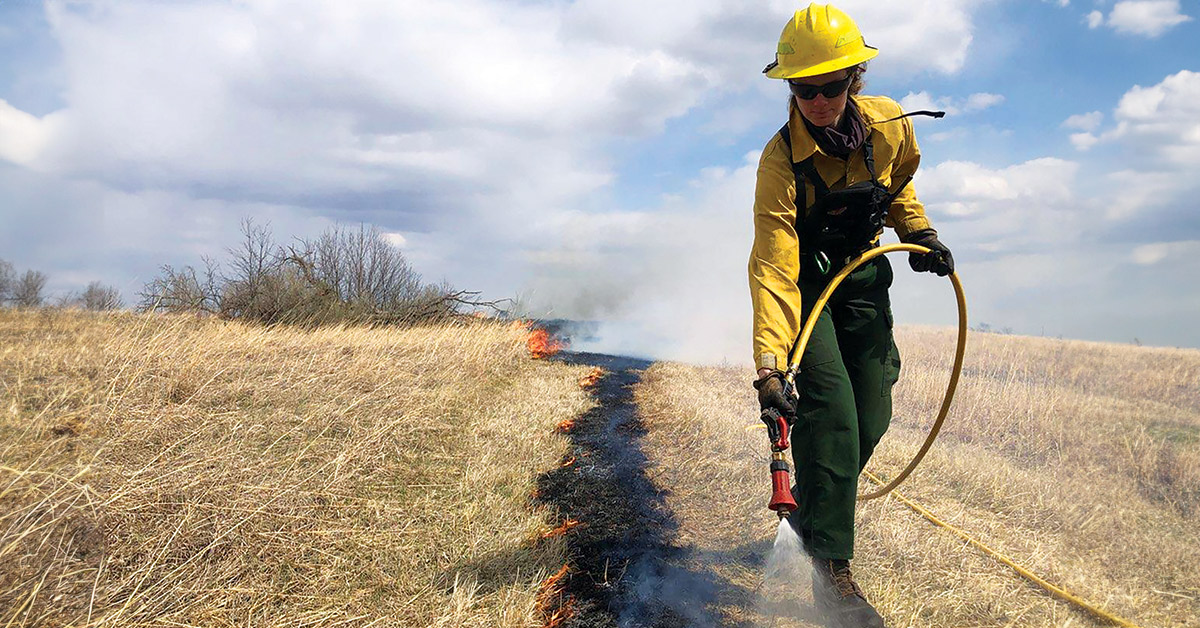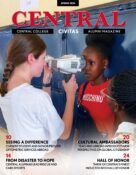
Former Central baseball catcher Kody Wohlers ’05 is among eight Iowans with a Prescribed Burn Boss Type 2 credential and has directed or partnered on more than 900 prescribed fires, largely through his work with the Iowa Natural Heritage Foundation.
Alone on a warm, early summer day, Kody Wohlers ’05 occasionally lets his gaze drift across the gentle slopes of western Iowa’s Loess Hills. A thrill washes over him, as sweet as the pure feel of bat meeting ball on the 10 home runs he clubbed as a Central College baseball player.
There are no cheering spectators, no high fives from jubilant teammates sharing the moment. But when he sees native prairie plants like compass plant, lead plant and purple prairie clover bursting into flower in once-charred soil where invasive cool-season grasses and dogwoods had taken over prior to a prescribed burn he directed, it’s a small win that shines as brightly as runs on a scoreboard.
“I would say that’s the most gratifying part of the work, is seeing that response,” Wohlers says. “A year after the fire, seeing what new plants are showing up, what it stimulates.”
Wohlers is Loess Hills land stewardship director for the Iowa Natural Heritage Foundation, among four former Dutch athletes, and seven Central grads overall, working for the organization. Created in 1979 with the help of Governor Robert Ray, the INHF works with private landowners and public agencies to protect and restore Iowa’s land, water and wildlife. Supporters and staff have protected more than 190,000 acres of Iowa land.
For Wohlers, it’s not a job but a lifelong mission, spawned as a small boy watching his grandpa install small check dams on his farm to minimize erosion but also slow the release of water, so precious to a cattle farmer.
Fire as a Conservation Tool
His grandfather’s efforts to channel a gently flowing Iowa creek contrasts with Wohlers’ help combatting an angry wildfire racing unpredictably across a Colorado mountainside, endangering not only trees and wildlife but homes and lives.
Fire brings danger and destruction, but in the fight to restore slivers of Iowa’s natural prairie to its vibrant 18th-century majesty, free of invasive species, it’s also among the most valuable weapons in conservationists’ arsenal. Understanding how to best use it can be accelerated through wildfire fighting, typically in the western U.S.
“Whenever we go west, we bring something back to INHF — we bring something back to Iowa and the people that are in the crews we’re managing to implement prescribed fire here in Iowa,” says Derek Miner ’15, another former Dutch baseball player now serving as an INHF land stewardship associate. “You get to utilize fire in different ways and use the tools around wildfire in different ways. You just bring back a whole suite of knowledge, and safety is a big part of that, too.”
The fires they direct can restore prairie health.
“Prescribed fire is a really big tool for us as land stewards in Iowa. Bringing back that natural process and natural stressor to the environment that a lot of our ecosystems rely on and they’re dependent on fire regimes,” Miner explains. “But it can’t be the only tool, with our fragmented landscape. We talk about land restoration a lot of times in terms of what it used to be 300 years ago. But we’re not operating these ecosystems in the same kind of environment.”
Over 16 years of training and study, Wohlers earned a Prescribed Burn Boss Type 2 credential through the National Wildfire Coordinating Group. He’s one of just eight Iowans with that credential. He has directed or partnered on more than 900 prescribed burns over 80,000 acres. He’s also helped fight more than 40 wildfires over 550,000 acres in 11 western states and two countries.
“It is a high-stress environment because when a fire is burning, you’re always on a ticking clock,” Wohlers says. “And a fire can change direction. It’s a very dynamic environment.”

After spending hours traveling together through their work with the Iowa Natural Heritage Foundation, former Dutch football defensive back Ryan Schmidt ’12 and former cross country/track and field athlete Melanie Louis Schmidt ’12 grew close and eventually married.
Playing Defense
At those times, Wohlers is directing the defense, much like he did as a catcher for the Dutch, positioning fielders as a dangerous hitter strides to the plate.
“I think it absolutely helps to be an athlete,” Wohlers shares. “Because you’re used to having that crew dynamic, that partnering, that cohesiveness, that dependence on somebody watching your back. As a two-year captain at Central being used to a leadership role and willing to take the reins and direct people and having a lot of communication, that played a big part in my career.”
Even prescribed burns carry risks.
“Every fire is different,” Wohlers explains. “Every day is different. And it’s a living, breathing thing. I always take the perspective of not taking it for granted. Respect it.”
While Wohlers is playing defense, during tense moments on the fire line, the mind of INHF Volunteer Coordinator Melanie Louis Schmidt ’12 flashes back to her days on the cross country course with the Dutch, pushing her body to its limits.
“The best way I can describe it is that race-day feeling when you’re kind of sweaty and your heart’s pumping and all of your senses are heightened,” she says. “And you just have to stay calm and collected because you can’t lose your train of thought. You really have to be in touch with what’s going on, inside your body and out.”
Yet she downplays the risk.
“This is always what I have to tell my parents because they definitely weren’t in favor of me doing this,” she laughs. “But because we are a crew that gets put together once a year and we’re a group of people who have never worked together, typically we’re not put in high-danger situations. That’s saved for the hotshots (full-time firefighters on the front lines of the most treacherous fires). I’m not saying the work is not dangerous. Any time you’re working with uncontrolled fire, there’s always danger. But there’s so much training that goes into preparing wildland firefighters. We’re constantly being reminded of things to keep an eye on and, especially when you’re on a crew, you’re constantly looking out for each other.”
Schmidt’s husband, Central Iowa Land Stewardship Director, Ryan Schmidt ’12, a former Dutch football defensive back, followed Wohlers into wildland firefighting and the stories he shared of the rigorous, demanding work excited her.
“After hearing about his experience out west, I just knew I had to try,” she says.

Fewer than 10% of wildfire fighters are female, but in addition to helping direct prescribed burns as shown above, Melanie Louis Schmidt ’12 often volunteers to help battle massive fires in the western U.S. and feeds off the challenge of the physical, demanding responsibilities.
Breaking Barriers
Fewer than 10% of wildfire fighters are female. But Melanie eagerly began proving her worth as a member of a 20-person hand crew.
“They’re hiking into the areas where fire suppression or any other kind of work is needed and where the fire engines can’t go,” she shares. “It’s typically physical work like digging line, laying out hose, digging trenches and things like that. So, it’s more physical, which in my personal opinion, is way better.”
Wohlers describes firefighting as a grueling experience.
“It’s a lot of sacrifice,” he says. “You’re usually gone from your families for a minimum of 16 days. But it’s also taken me to parts of the country that I would never have seen on my own dollar.”
Albeit with long hours, Melanie adds.
“It is very exhausting,” she expresses. “We probably get up between 4:30 and 5 (a.m.) and then we’re on the land out around the fire until about 7 at night and we’re crawling in bed by like 9 or 10. So they’re 16 to 18-hour days. And you’re typically camping. You’re sleeping outside at an area that they designate as fire camp — you’re basically eating, sleeping and breathing the fire environment.”
Sleep doesn’t always come easily, she mentions, and not just because she’s among a group of grimy firefighters sprawled on the ground, tents faintly illuminated by the glow of the distant fire.
“The first couple of days, it’s really hard to shut your mind off but after day two or three, you’re so physically and mentally exhausted that your body just knows what to do,” she explains. “And they feed you so much food that I’m sure half of it is probably food coma, which is fine because you burn so many calories.”
Returning to the land of daily commutes, emails and fixing supper after a couple of adrenaline-drenched weeks in the wilderness can be jarring.
“It’s really a culture shock in some ways,” Ryan shares. “Getting back in touch with your family, your friends, your daily job — it’s a different world. When you’re out west, you’re not listening to the radio, you’re not seeing any national news. You’re focused on the task at hand. You’re essentially on an island.”
Planting the Seeds
The roads that led the Central grads to the INHF differ, but the common thread for most is the inner curiosity about the natural world awakened by Central faculty members Russ Benedict, professor of biology, Paul Weihe, associate professor of biology, and Anya Butt, professor of biology.
“Dr. B (Benedict) was a huge inspiration in my life to get into prairie research that he was doing and learning more about plant species and things like that,” Melanie says.
Central typically sends at least one intern to the INHF annually, according to Benedict. It can be a life-changing opportunity.
“It all kind of opened my eyes to what is out there and there’s actually a career here if I work hard enough to go out and get it,” Miner shares.
It altered Melanie’s perspective as well.
“As I learned more about Iowa’s landscape and the plants that make it so special, I definitely turned into a prairie nerd,” she says. “I never would have thought I would be so into plants as I am now.”
In Benedict’s experience, that’s a common transformation, often sparked by work at Central’s 80-acre Carlson-Kuyper Field Station.
“If there’s already a bit of a seed there, once you get kids out and immerse them in nature, it’s fairly easy to ignite that fire,” Benedict says.

As Loess Hills land stewardship director for the Iowa Natural Heritage Foundation, Kody Wohlers ’05 frequently directs prescribed burns like the picture above, which can help restore Iowa’s native prairie plants. Less than one-tenth of one percent of Iowa’s remnant prairie remains.
A Love for the Land Between Two Rivers
For INHF employees, that passion is fueled by a love for Iowa. The state maximizes the use of its fertile soil to raise the crops and livestock the world demands. But that use comes at a price. The state that was once blanketed with natural prairie and abundant wildlife between its two mighty rivers is forever changed.
“Iowa is the most altered state in the union,” Wohlers explains. “We have one-tenth of one percent of remnant prairie remaining.”
Yet as Wohlers pauses to survey the western Iowa landscape, it’s still possible to catch glimpses of an Iowa that no longer exists, seen now only in paintings and in the mind.
“I regularly catch myself doing that,” he says. “You know, standing on a hilltop. Most of the time when you look across a valley or a river bottom, it’s all agricultural now but I think, ‘What was it like without all the deciduous trees or the cedar trees on that hill, when all the river bottoms were 6 to 8 feet tall and native prairie?’ I try to picture in my head seeing prairie all the way to the horizon. It’s tough to imagine, but something that excites me. It would have been fantastic to see.”
Protecting what’s left of that picture, and finding ways to restore the health of an increasingly fragile environment one fire, one plant at a time, keeps these conservationists energized, even while some leaders ignore the steady stream of frightening news about the planet’s future.
“It can be super depressing,” Melanie admits. “You’ve just got to find the little wins. And the people that are trying to make a difference, everything we do matters.”
Athletics Updates
MEN’S CROSS COUNTRY: Caleb Silver ’24 finished ninth in Division III, the second-highest NCAA finish in program history, while Noah Jorgenson ’24 placed 24th to gain All-America distinction and lead Central to a 15th-place team finish.
WOMEN’S CROSS COUNTRY: In placing ninth at the NCAA Division III Championships in Newville, Pennsylvania, the Dutch recorded their highest finish since winning the national title in 1981. Caroline McMartin ’24 was 12th individually with Megan Johnson ’24 and Addison Parrott ’25 joining her as All-America honorees.
FOOTBALL: Central was 8-2 overall and 6-2 in American Rivers play. Ten players were named to the all-conference squad. Linebacker Brody Klein ’24, offensive tackle Kade Tippet ’25, kicker Logan Sunvold ’24 and return specialist Hunter Wilkinson ’24 were first-team selections.
WOMEN’S GOLF: Mackenzie Biggs ’24 earned all-conference honors for the fourth time by placing fourth in the American Rivers tournament. Lydia Grond ’25 was cited for the second time as the Dutch placed second in the team standings.
MEN’S SOCCER: Forward Noah Piedimonte ’27 received an all-conference distinction. A young Dutch squad was 7-8-2 overall with a 3-5 conference record.
WOMEN’S SOCCER: Forward Grace Coates ’25 and midfielder Paige Cahill ’24 were second-team all-region picks. Central was 9-5-4 overall and 4-3-1 in the conference, tied for third place.
WOMEN’S TRIATHLON: Grace Benson ’26 received All-America honorable mention after finishing 21st in Division III at the USA Triathlon Collegiate National Championships in Tempe, Arizona. Central was eighth among 11 Division III schools in the meet.
WOMEN’S TENNIS: Central was fifth in the conference at 4-4 with a 6-6 overall mark. The Dutch will return most of their starting lineup next fall.
VOLLEYBALL: Central gained a conference tournament berth, improving to 22-10 overall and 4-4 in the league. Libero Colleen Kenney ’26 was named the conference defensive player of the year.
For an up-to-date schedule of all sports, visit athletics.central.edu/calendar.












To encourage serious, intellectual discourse on Civitas, please include your first and last name when commenting. Anonymous comments will be removed.